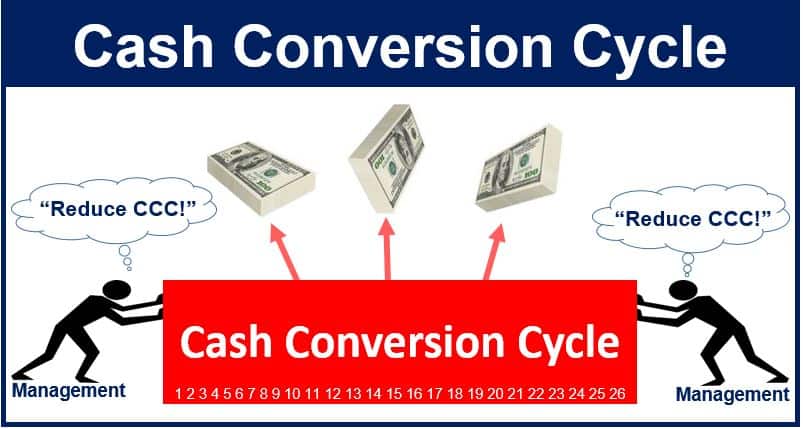What is the cash conversion cycle? Definition and example
The Cash Conversion Cycle or CCC is a management accounting measure. The CCC determines how long money we have invested remains tied up before appearing in a company’s cash flow. It is a measure of liquidity risk, specifically when a business grows. In fact, investors and analysts use the CCC to compare different companies’ financial health.
The terms cash cycle and net operating cycle mean the same as cash conversion cycle.
Put simply; the calculation tries to measure how long we have tied up each net input unit of currency in production and sales. Subsequently, sales will materialize, and the money begins to return.
In other words, CCC measures how long the return on investment process is.
The calculation looks at how long it takes to sell inventory, collect receivables, and pay invoices.

The aim of studying the cash conversion cycle is to determine whether a company’s credit policies are suitable. In other words, whether its credit purchase and credit sales policies are the right ones.
If the CCC points to a poor cash liquidity position, the company needs to change its credit policies.
Analysts compare the CCC readings of different companies. They can subsequently determine how good or bad their cash management is.
Cash conversion cycle formula
We calculate the CCC by adding the days inventory outstanding to the days sales outstanding, minus the days payable outstanding.
CCC = Days Inventory Outstanding + Days Sales Outstanding – Days Payable Outstanding
We calculate the CCC by following the money as it initially converts into inventory and accounts payable, through sales and accounts receivable, and then back into cash. Accounts payable is money owed to creditors while accounts receivable is money our debtors owe us.
Companies with a low CCC number are in a better financial position than those with high numbers.
Cash conversion cycle example
Imagine the inventory of John Doe Inc. sits in the warehouse for 10 days. It usually takes 20 days to collect on the sale of each order. John Doe takes 20 days to pay invoices to its suppliers.
Using the above formula. John Doe’s cash conversion cycle is:
Cash Conversion Cycle = 10 + 20 – 20 = 10 days
This means that John Doe generates cash from assets within ten days.
According to Nasdaq.com, the cash conversion cycle is:
“The length of time between a firm’s purchase of inventory and the receipt of cash from accounts receivable.”

